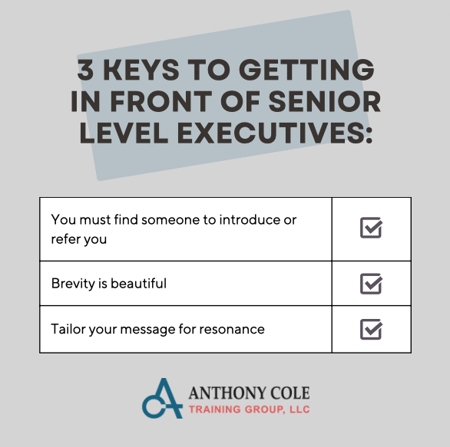While there are many differences between elite salespeople and average salespeople, two of the more important distinctions are the ability to sell value (they can sell at a slight premium on price) and the ability to reach the top levels of the prospect’s decision-making team (typically the C-Suite).
It is the second of those two distinctions that serves as the title and the focus of this blog. Average salespeople are quite comfortable and successful seeing the non C-suite members of the decision-making team. Why are salespeople so comfortable with these people? The answer is quite simple – because these people are easy to see. They offer very little resistance. So here is a general rule of thumb: the easier the person is to get in front of, the less likely they will play a significant role in making the ultimate decision. To quote Eleanor Roosevelt, “never let anyone tell you no unless they also have the power to tell you yes.”
Here are 3 keys to getting in front of senior level executives:
- You must find someone to introduce or refer you. Recent studies have revealed that 80% of senior executives when surveyed have responded that they are extremely unlikely to meet with you or return your call or reply to your email if they don’t know you and your firm. Cold calling, while for the most part is never effective is even worse when you are calling the top level of the organization.
- Brevity is beautiful. As Thomas Jefferson once said, “the most valuable of all talents is never using two words when one will do.” C-Suite executives have the attention span of an 8-year-old in front of a broken-down ice cream truck on a hot summer day. Keep it simple. Keep it short.
- Tailor your message for resonance. Are you talking about issues that matter to senior executives? Are you speaking their love language (talking about problems and solutions)? If not, you are easy to ignore.
Happy selling. I need to go. I think I hear the ice cream truck heading by our office.

Topics:
sales succes,
sale skills,
decisions
In Part 1 of "Negotiating on the First Tee, we discussed the practice of negotiating with your prospect before you begin your presentation. In Part 2, we continue this discussion and add more to the conversation.
In order to increase sales and close more deals, you must understand the client's business strategy, build a strong foundation for negotiation, and cross off all the boxes for a killer Sales DNA.

- Establishing the ground rules for time of presentation are critical. Before we get to that though, you must have a transitional discussion
- "Let me take a minute to review where I think we are..."
- "You have the following issues a,b, and c that if not taken care of within this time frame will cause the following to happen and this outcome is a have to fix problem"
- "Your capacity to invest time, money and effort to fix the problem is this…"
- "And I’m assuming for a minute that if we are able to fix this for you, in the budget you’ve identified with the right criteria and priorities, you would also want me to be in a position to answer any and all questions at that time"
- "Did I get this right?" (Buyer says yes)
- "Good, assuming we can do this I will be prepared to do all those things. If I can’t, I will call in advance and cancel our presentation meeting. Fair?" (Fair)
- Ground rules discussion:
- "It may not be effective here, but there is a process that we recommend to make sure we are all on the same page, can I share that with you?" (Yes)
- I need for you to be prepared as well:
- "As I am going through my presentation, you will be thinking one of 2 things: 1) this makes all the sense in the world; let’s do this, 2) This won’t work for me, the money is wrong or I don’t think there is a fit"
- "When I’m finished, I’m going ask you which one you are thinking. What objections do you have to that process?"
- Anticipate and prepare for objections when you complete step six. Keep in mind that an objection, stall or questions does NOT mean they are telling you no. They just need more information or you need to find out more clarity about compelling issues, capacity to invest or clarity on decision making. At the end, you do your best to eliminate any TIOs (Think It Overs)
- Let's assume for a minute that this works for you. You are not done minimizing the opportunity for negotiation at time of presentation. When you finish this discussion, you must return to your office and write out and send the "As we agreed to letter" that covers the 3 “Cs” and inform the buyer you will call to confirm the information you’ve sent. Then call to confirm.
- Presenting to get a decision is as much of a mindset as it is a process:
- Review what you’ve discussed
- Review the as we agreed to letter including money and decision process that will take place today
- Ask, “What’s changed?”
- Make the presentation starting with their priority item not the first page in your presentation
- Answer all of their questions about each solution, get them to score that solution on a scale of 1-10. If you are 7 or better you are in good shape but still you need to get them to a ten. Once you get the ‘10’ you check that item off.
- Ask our closing question:
- "What where you thinking as I went through this. Assume for this discussion they said, This is really great we should do this!
- You ask, what should we do now?
- Or your alternative is:
- Do you believe based on what we presented that we understand your business and what you are trying to accomplish?
- Do you feel we can help?
- Do you want our help?
- Despite this great process and effort, you can expect buyers to ask you questions that they haven’t asked yet, raise objections, or present you with stalls. The first thing is this: Be prepared by conducting pre-call strategy meetings and role play these challenges. Always understand that prospects are looking out for their best interests and not yours. Do not get emotionally involved when they throw you the curve ball!
Now I bet you are thinking, Tony, where is all the negotiation stuff? Well that’s it right there. You win the bet on the first tee.
Topics:
compelling reasons to buy,
communication,
communicating expectations,
cost of hiring mistakes,
crucial elements,
desire for success,
consistent sales,
commitment to succeed,
commitment,
decisions,
desire,
creating habits for success,
coaching salespeople,
evaluating salespeople,
developing sales skills,
evaluating sales teams,
creating sales habits,
core values and beliefs,
creating advocates,
consistent sales results,
consultative selling,
create & convert leads,
complacency,
contacting prospects,
deal or no deal,
creating new sales opportunities,
consultative sales coaching,
corporate sales training,
consultative sales coaching cincinnati,
consultative selling cincinnati,
corporate sales training cincinnati
Here are five sales benefits of calling at the top when you prospect:
- You will have the attention of the ultimate decision maker of the sale
- You will shorten your sales cycle as a result of being with the decision maker
- When you run into problems with people that manage or administer your program, service or product you have a relationship with someone that can fix the problem.
- If the problems you uncover are real problems you will be in front of the person that will find the money to fix the problem and complete the sale
- When you call at the top you will know if a current relationship will derail you from getting the sale.
Your decision when you are prospecting is to decide: How important is it for you to have these 5 sales benefits. If these benefits won't help you sell more business, more quickly at higher margins then keep calling on those that can only tell you know, limit your budget, and limit your abililty to effectively implement a plan, program or service the exceeds the prospects expectations.
Topics:
Sales,
prospects,
sale,
expectations,
sell more business,
decisions



